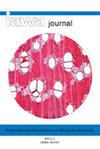银杏木材定量解剖实用指南。
IF 3.5
3区 农林科学
Q2 FORESTRY
引用次数: 1
摘要
银杏(Ginkgo biloba L.)是一种长寿的孑遗物种,具有很高的生态、文化和经济价值。研究双叶树木材的定量解剖,对了解双叶树生长与气候变化的关系具有重要意义,有助于对双叶树古树的保护。制备高质量的木材薄片是定量木材解剖分析的前提。此外,图像分析的人工校正是一个耗时的过程。因此,我们提出了如何制作高质量木质部薄片的方案,从样品制备,样品包埋,叶片选择到厚度选择。我们还提出了一种方法来确定必要的样本宽度和岩心数量,以建立可靠的木材解剖时间序列,既可以捕获气候信号,又可以减少用于图像分析的时间。显微切片制备时,将玉米淀粉溶液涂于样品表面后,用Leica DB80刀片切割20-30 μm厚的切片。对于图像分析,在测量6个芯(树)或以上时可以建立可靠的木材解剖时间序列,并在沿着增量芯(偏差<2%)分析1.2 mm宽的径向条时捕获环境信号,以获取参数细胞密度,平均流通面积,潜在水力传导率和导电面积百分比。本文为成功地应用定量木材解剖方法研究双叶木质素提供了实践指导。希望本研究能为今后对双叶桐及类似树种的木材定量解剖研究提供一定的帮助。本文章由计算机程序翻译,如有差异,请以英文原文为准。
Practical guidelines for quantitative wood anatomy on Ginkgo biloba L.
Ginkgo biloba L., a long-lived relict species, has high ecological, cultural and economic value. Studying the quantitative wood anatomy of G. biloba is important to understand the relationships between their tree-growth and climate change, which could help in the protection of old G. biloba trees. Preparing high-quality wood thin sections is the premise of quantitative wood anatomy analysis. In addition, manual correction of image analysis is a time-consuming process. We therefore present a protocol on how to make G. biloba high-quality xylem thin sections, from sample preparation, sample embedding, blade selection to thickness selection. We also present a method to determine the necessary sample width and number of cores to establish reliable wood anatomical time series that both can capture climate signals and reduce the time used for image analysis. For microsection preparation, it is optimal to cut 20–30-μm-thick sections using Leica DB80 blades after applying the cornstarch solution on top of the sample surface. For image analysis, the reliable wood anatomical time series can be established when measuring six cores (trees) or above, and the environmental signals are captured when analyzing a 1.2-mm-wide radial strip along the increment core (deviation <2%) for the parameters cell density, mean lumen area, potential hydraulic conductivity and percentage of the conductive area. This paper provides practical guidance to successfully use quantitative wood anatomy methods on G. biloba. We hope our study will be helpful for future research on the quantitative wood anatomy of G. biloba and similar tree species.
求助全文
通过发布文献求助,成功后即可免费获取论文全文。
去求助
来源期刊

IAWA Journal
农林科学-林学
CiteScore
3.40
自引率
15.80%
发文量
26
审稿时长
>36 weeks
期刊介绍:
The IAWA Journal is the only international periodical fully devoted to structure, function, identification and utilisation of wood and bark in trees, shrubs, lianas, palms, bamboo and herbs. Many papers are of a multidisciplinary nature, linking
 求助内容:
求助内容: 应助结果提醒方式:
应助结果提醒方式:


